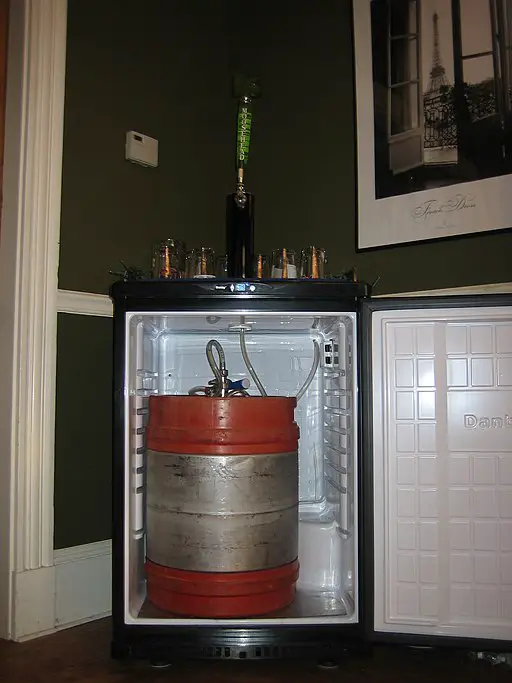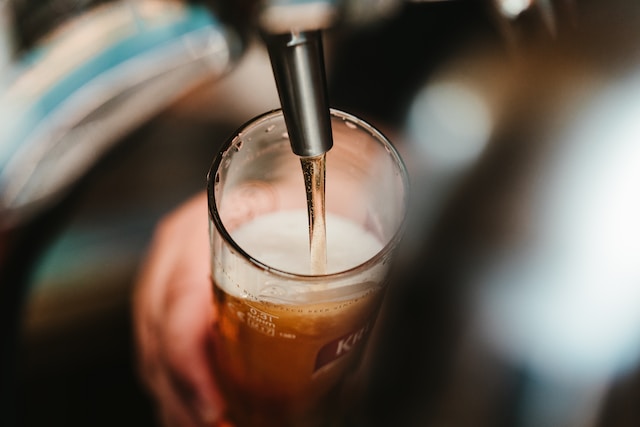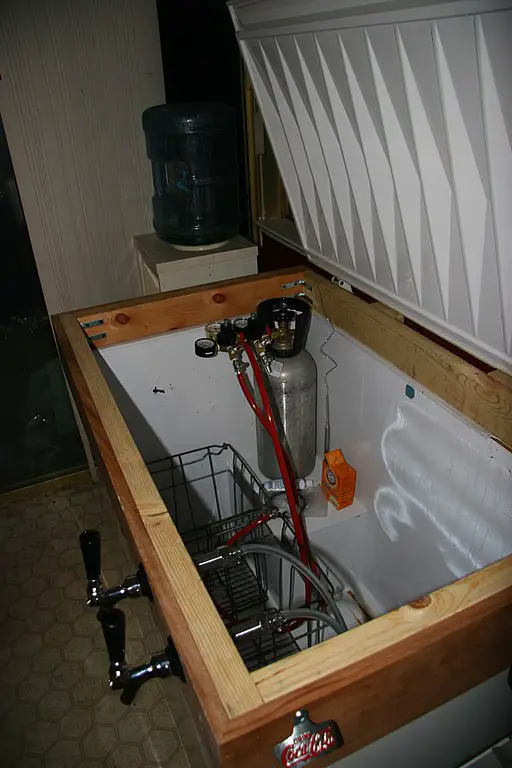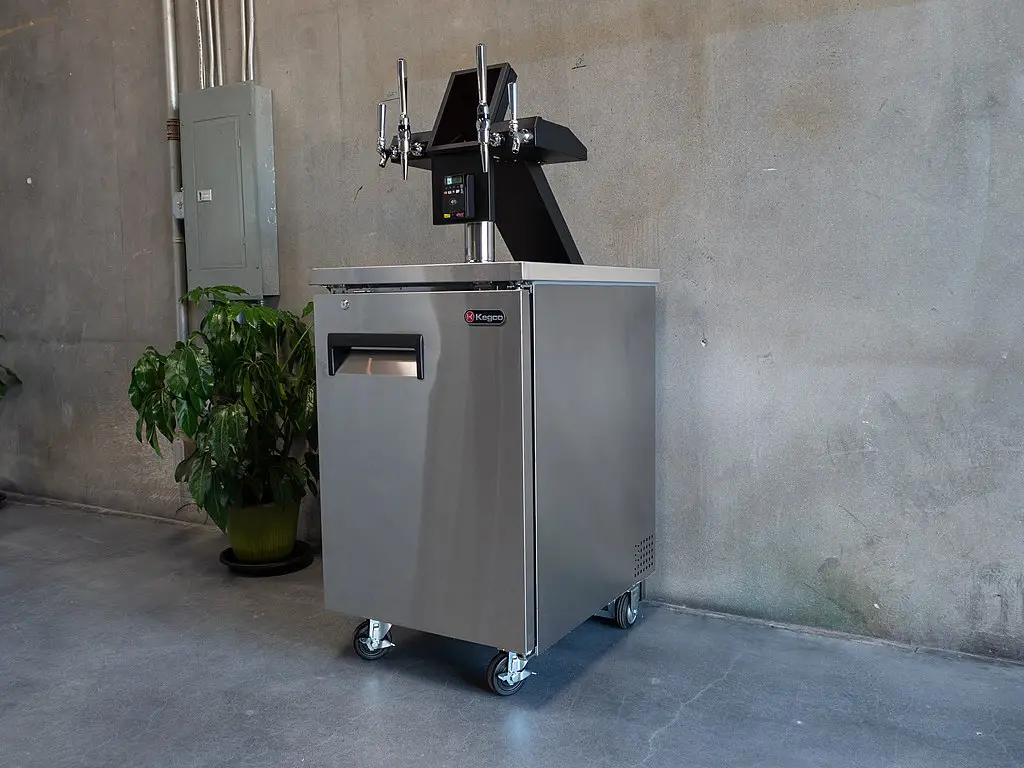Are you a beer enthusiast looking to add a kegerator to your home bar? Or maybe you already have one and wonder about the kegerator capacity and how many beers you can fit inside? Well, you’re in luck because we will unlock the mystery for you!
The number of beers your kegerator can hold depends on several factors, like the size of the kegerator, the type of keg, and the size of the beer glasses you plan to use. But don’t worry, and we’ve done the research and calculations for you. In this article, we’ll explore the different kegerator sizes, keg types, and glass sizes to help you figure out how many beers you can fit in your kegerator. So sit back, grab a cold one, and let’s dive into the world of kegerators!
Featured Image – Krats22, CC BY-SA 4.0, via Wikimedia Commons
Certain links and images on this page may contain affiliate links in which we may receive a commission. See our affiliate disclosure for details.
Table of Contents
What is a kegerator?
A kegerator is a refrigerator that is designed to hold and dispense beer kegs. It is an essential tool for any beer enthusiast, allowing you to have your favorite beer on tap at home. Kegerators come in various sizes, from small countertop models to large commercial units. They are available in indoor and outdoor models, making them perfect for any home bar or outdoor entertainment area.
A kegerator typically has a tap and a CO2 tank for dispensing the beer. The CO2 tank pressurizes the keg, forcing the beer through the tap and into your glass. The temperature of the kegerator is adjustable, allowing you to keep your beer at the perfect temperature for optimal taste.
How does a kegerator work?
A kegerator works by using a combination of refrigeration and pressurization to keep the beer cold and dispense it through a tap. The beer is stored in a keg, which is placed inside the kegerator. The kegerator is equipped with a tap, which is connected to the keg through a hose. When you open the tap, beer flows out of the keg, through the hose, and into your glass.
The CO2 tank is used to pressurize the keg and keep the beer carbonated. The pressure in the keg is regulated by a pressure valve, which is connected to the CO2 tank. The pressure valve ensures that the beer is dispensed at the right pressure, which prevents foaming and ensures that the beer tastes great.
Types of kegerators

Various types of kegerators are available in the market, ranging from small countertop models to large commercial units. Some of the most common types of kegerators include:
Countertop kegerators
Countertop kegerators are small, compact units that are designed to sit on a countertop or table. They are perfect for small spaces and are ideal for home use. Countertop kegerators are available in various sizes and can hold one or two kegs, depending on the model.
Freestanding kegerators
Freestanding kegerators are larger units that are designed to stand on the floor. They are available in various sizes and can hold multiple kegs. Freestanding kegerators are perfect for larger home bars and outdoor entertainment areas.
Built-in kegerators
Built-in kegerators are designed to be installed into a countertop or cabinet. They are perfect for custom home bars and outdoor kitchens. Built-in kegerators are available in various sizes and can hold one or two kegs, depending on the model.
Commercial kegerators
Commercial kegerators are large units that are designed for use in bars, restaurants, and other commercial settings. They are available in various sizes and can hold multiple kegs.
Factors to consider when choosing a kegerator
When choosing a kegerator, there are several factors that you need to consider. These include:
Size
The size of the kegerator is one of the most important factors to consider. You need to choose a kegerator that is the right size for your space and the number of kegs you plan to store. If you have limited space, a countertop or built-in kegerator may be the best option. If you have a large space and plan to store multiple kegs, a freestanding or commercial kegerator may be a better choice.
Type of keg
The type of keg you plan to use is also an important factor to consider. There are two main types of kegs: full-size kegs and pony kegs. Full-size kegs are larger and hold around 15.5 gallons of beer, while pony kegs are smaller and hold around 7.75 gallons of beer. Make sure that the kegerator you choose is compatible with the type of keg you plan to use.
Glass size
The size of the beer glasses you plan to use is also an important factor to consider. The larger the glass, the fewer beers you will be able to fit in your kegerator. Make sure that you choose glasses that are the right size for your kegerator and the number of beers you plan to store.
Calculating the number of beers a kegerator can hold

Calculating the number of beers a kegerator can hold is a simple process that involves a few basic calculations. To calculate the number of beers a kegerator can hold, you need to know the size of the kegerator, the type of keg, and the size of the beer glasses you plan to use.
Step 1: Determine the size of the kegerator
The first step is to determine the size of the kegerator. This is usually measured in cubic feet. To calculate the cubic feet of your kegerator, you need to multiply the height, width, and depth of the kegerator.
Step 2: Determine the size of the keg
The next step is to determine the size of the keg you plan to use. This is usually measured in gallons. Full-size kegs hold around 15.5 gallons of beer, while pony kegs hold around 7.75 gallons of beer.
Step 3: Determine the size of the beer glasses
The final step is to determine the size of the beer glasses you plan to use. This is usually measured in ounces. The most common beer glass sizes are 12 ounces, 16 ounces, and 20 ounces.
Once you have this information, you can use the following formula to calculate the number of beers your kegerator can hold:
(Number of cubic feet in the kegerator x 1728) / (Size of the keg in gallons x Size of the beer glass in ounces)
For example, if you have a kegerator that is 5 cubic feet in size, and you plan to use a full-size keg and 16-ounce beer glasses, the calculation would be:
(5 x 1728) / (15.5 x 16) = 42.6 beers
Tips for maximizing your kegerator’s capacity
If you want to maximize the capacity of your kegerator, there are several tips that you can follow. These include:
Use smaller glasses
Using smaller glasses can help you fit more beers in your kegerator. Instead of using 20-ounce glasses, try using 12-ounce glasses.
Stack kegs
If you have a freestanding or built-in kegerator, you can stack kegs on top of each other to maximize space and improve your kegerator capacity. Just make sure that you have enough clearance between the kegs and the tap to allow for easy dispensing.
Use a dual-tap kegerator
If you plan to store multiple kegs, consider using a dual-tap kegerator. This will allow you to store two kegs and dispense them both from the same unit.
Maintaining your kegerator for optimal performance
To ensure that your kegerator performs at its best, it’s important to maintain it properly. This includes:
Cleaning the tap and beer lines
It’s important to clean the tap and beer lines regularly to prevent the buildup of bacteria and other contaminants.
Checking the CO2 tank
Make sure that the CO2 tank is full and that the pressure is set correctly.
Checking the temperature
Check the temperature of the kegerator regularly to ensure that it is set at the right temperature for your beer.
Common kegerator problems and how to troubleshoot them

Despite proper maintenance, kegerators can sometimes experience problems. Some of the most common kegerator problems include:
Beer foam
If your beer is foaming too much, it could be due to a clogged tap or beer line. Try cleaning the tap and beer lines to see if that helps.
Warm beer
If your beer is too warm, it could be due to a malfunctioning thermostat or a dirty condenser. Try cleaning the condenser and checking the thermostat to see if that helps.
Low pressure
If the pressure in your kegerator is too low, it could be due to a leak in the CO2 tank or regulator. Try checking for leaks and replacing any damaged parts.
DIY kegerator projects
If you’re handy with tools and want to save some money, you can also build your own kegerator. Many DIY kegerator projects are available online, ranging from simple to complex. Some of the most popular DIY kegerator projects include using an old refrigerator or freezer and converting it into a kegerator.
Final Thoughts About Kegerator Capacity
In conclusion, the number of beers a kegerator can hold depends on several factors, like the size of the kegerator, the type of keg, and the size of the beer glasses you plan to use. By following the tips and calculations outlined in this article, you can determine just how many beers your kegerator can hold. Remember to maintain your kegerator properly to ensure optimal performance, and don’t be afraid to tackle a DIY kegerator project if you’re feeling handy. With the right kegerator, you can enjoy your favorite beer on tap at home, whenever you want!





